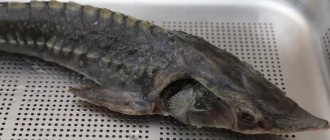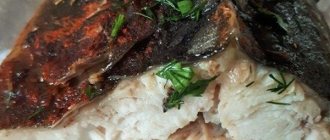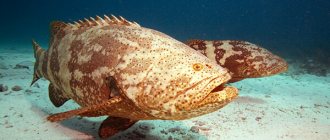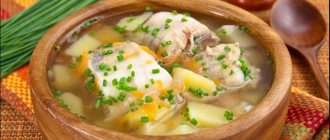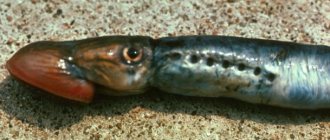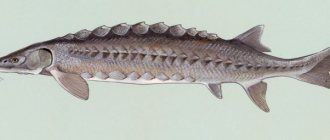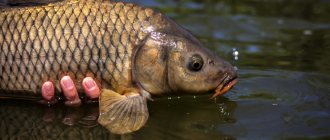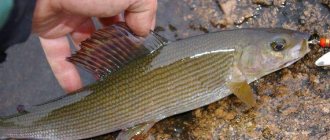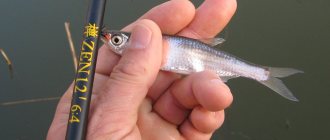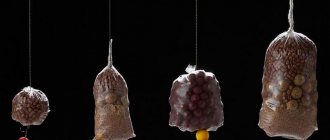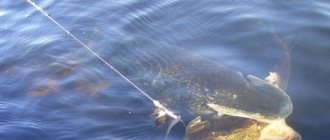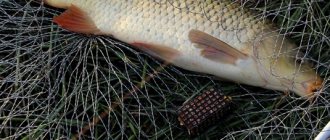Where to catch sturgeon
Habitats
In the European part of our country, sturgeon lives in the Caspian, Azov and Black Seas, as well as in the rivers flowing into them. It can also be found in the rivers of Siberia. It is also found in lakes, for example, in Baikal and Zaisan. In addition to this, it is also bred in paid stocked reservoirs.
Permitted and prohibited fishing areas
Industrial fishing of sturgeon is permitted only in some areas of Siberia, where people still live by subsistence farming. However, even they can catch only 55 tons of sturgeon per year.
Amateur sturgeon fishing is permitted in any region of our vast country, but only on paid ponds and with a permit. Catching this fish in open waters is prohibited and punishable by law.
What is the penalty for illegal fishing?
Each region of the country has its own rules about what kind of fish and in what quantities can be caught. But it is strictly forbidden to catch sturgeon, regardless of the region:
- For example, for one caught Atlantic sturgeon you will have to pay a fine of 40,000 rubles, regardless of the region where you catch it.
- For catching sturgeon in Siberia, a fine of up to 1,000,000 rubles is imposed, as well as imprisonment for up to 3 years.
- If you decide to fish for a representative of the Red Book during spawning, then be prepared to shell out up to 300,000 rubles from your pocket.
In this case, you will have to pay for each individual caught. You also need to remember that for catching fish that is in the Red Book, you face criminal liability under Article 281 of the Criminal Code of the Russian Federation.
Reservoir type and habitat depth
Sturgeon lives in water bodies of all types. This fish can be found in rivers, lakes, and seas. Sturgeon is considered a bottom fish, so depending on the body of water, it can be found at a depth of 2 to hundreds of meters.
Where can you catch sturgeon?
Let's look at the main places on the reservoir where you can catch this fish:
- Sturgeon very often choose the deepest places in the reservoir for rest. Therefore, if you find a hole at the bottom, it makes sense to fish for it.
- The place where the tributary flows into the main body of water is considered catchable. This is explained by the fact that such places are saturated with oxygen, and sturgeon, as an active fish, likes this.
- You can also catch it in places with a soft bottom. He “goes out” there to feast on insect larvae.
- Fishing in places where shallow water smoothly turns into depth can also be successful. In such places this predator prefers to hunt fry.
- Sturgeon can also be caught in shallow water. It often feeds at depths of up to 1 meter.
- If you decide to go to the lake, the best places for fishing will be the various slides at the bottom. These may be hills overgrown with algae, or rocky formations.
What is the best time to fish?
Fishing for sturgeon at night is prohibited in our country. Therefore, if you want to fish in the dark, you will have to go to a paid reservoir. During the daytime, it is preferable to fish before 10 a.m., or after 4 p.m.
Gear selection
Sturgeon fishing is very similar to carp fishing. The thing is that these fish prefer to live in holes at the bottom of the reservoir. Therefore, it is more profitable to use float and bottom fishing rods for fishing.
Bottom tackle
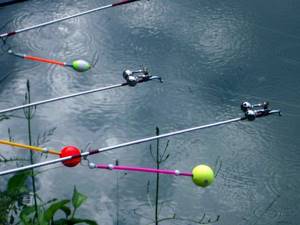
- Rod. The length of the rod should not be less than 4 meters. It is advisable to choose a fishing rod from the range of 4-6 meters, as you will have to make long casts. A carp or feeder rod is perfect for fishing. You should also pay attention to the quality of the guide rings. They should be made, for example, of ceramics or silicon carbide.
- Coil. Beginners should give preference to a spinning reel. If you have experience in handling a multiplier reel, then you can use it. The main thing is that the reel you want to use has a large spool. It’s good if it can accommodate 150 meters or more.
- Main line. Sturgeon is a very strong fish, and when fishing it can cause big problems for the fisherman. Therefore, all gear must be reliable, including the main fishing line. You can use either monofilament or braided fishing line with a diameter of 0.3-0.4 mm. The color of the line does not matter as this fish is not considered to be shy. The fishing line must withstand a load of at least 10 kg before it breaks.
- Leashes. For leashes, you need to choose a thinner fishing line, for example, with a diameter of 0.2-0.25. But you shouldn’t overdo it and use leashes that are too thin, as they will very often get tangled on the main line. It is advisable to “knit” leashes at a distance of at least 0.5 m from each other. Moreover, it is much more practical to make them removable. To do this, you can tie a regular loop at the end of the fishing line or tie a carabiner. If necessary, for example, if longer leads are needed, they can be quickly replaced. As for the length, you need to stock up on leashes of different sizes - from 0.5 to 1 m.
- Sinker. Depending on how far you plan to cast the rig, what the strength of the current is in the intended fishing location and the thickness of the main line, you need to select a sinker. Longer casts require heavier weights. It is also worth paying attention to the shape of the load. Flat sinkers cope well with the current and do not cling to plants on the bottom, since when reeling in the tackle they do not drag along the bottom, but are in the water column. However, flat sinkers also have disadvantages: when casting, they behave like a sail, and when they get into the water, they carry the hooks far from the casting point. You can also use drop-shaped and cone-shaped sinkers - they have good streamlining, do not cling to aquatic vegetation and have good flight characteristics. To catch sturgeon, a weight of 50-100 g will be enough. Moreover, it is advisable to have several weights of different weights with you so that you can choose the optimal one for the fishing conditions.
- Hooks. You can use carp. Depending on the bait and expected catch, hooks No. 3-7 are suitable. It is important that they have a long fore-end. This is necessary to make it easier to pull the hook out of the mouth of the caught fish.
Float tackle
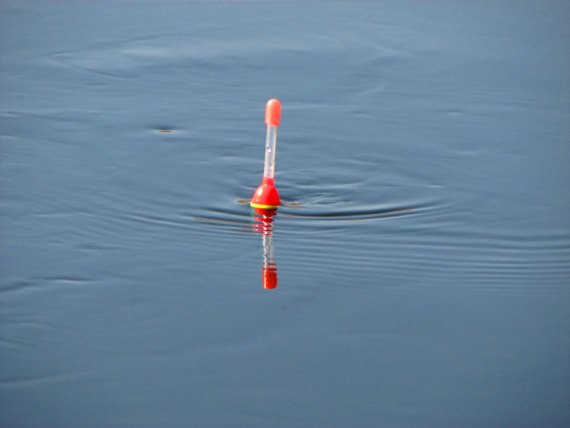
- Rod. A very durable match rod with a test weight of no more than 30 g is suitable. Otherwise, it must meet the same requirements as a rod for bottom fishing.
- Coil. For float fishing, it is better to install a match reel. It must have a large diameter spool that can hold at least 150 meters of fishing line, as well as a rear drag. You should pay special attention to adjusting the clutch, since sturgeon can reach large sizes and resist strongly when fished.
- Main line. Suitable fishing line for match fishing. The diameter of the main line is 0.18-0.3 mm. The fishing line must be sinking, low-stretch, and also resistant to abrasion.
- Leashes. To make leashes, you can use a special leash or fluorocarbon fishing line. A fishing line with a diameter of 0.18-0.24 mm is suitable. Otherwise, it should meet the same qualities as the leader line for the donkey.
- Float. Waggler type floats are suitable. It’s good if they have their own weight, for example, 7+3 or 5+5 g. The “Wagler” needs to be loaded so that during fishing only the float antenna is visible above the water, and its body is under water. This will allow you to see even the most reluctant bite, and will also reduce the effect of wind on the float. If you fish on a river, it is preferable to use a straight “waggler” made of peacock feathers. If it is not possible to use a “wagler” type float, then a regular lake float will do.
- Sinker. In order to properly load the tackle, it is worth purchasing lead pellets calibrated by weight. It is necessary to select sinkers in accordance with the float test. It is best to make do with 5-6 pellets, placing them at a distance of 5-10 cm from each other. Moreover, the pellets should be placed in the following order: the closer to the hook, the less mass the sinker should be. This arrangement of sinkers makes the tackle very sensitive.
- Hooks. As for the hooks, there is no difference compared to those used when fishing with donk.
Tackle
Stories about someone catching a sturgeon on a spinning tackle may have some basis. But this happens extremely rarely and only with a very slow jig with long pauses, during which the not very fast sturgeon will have time to overtake the bait and press it to the bottom. Basically, fishing for sturgeon on a platform is carried out using two types of gear: a donka and a float rod.
Float tackle
Depending on the fishing distance, and this is determined by the topography of the reservoir, you can use a fly rod or a plug rod. Experiments with Bolognese tackle on paid sites did not end very positively. On popular reservoirs in the Moscow region and other regions there are sometimes so many fishermen that there are fishing rods on the shore every couple of meters. Fishing for a sturgeon in such conditions must be done quickly, and given that, having risen to the surface, it can make high jumps, the neighbors will either have to pull out the gear while the lucky one gets the trophy, or then all together untangle everything that the sturgeon managed to collect. In addition, Bolognese fishing rods do not have sufficient strength, and very often their upper part simply breaks at the most crucial moment. A fly rod or plug rod allows you to avoid this in most cases.
The rig itself is quite simple and resembles the rig for crucian carp. This is explained by two facts. Both sturgeon and crucian carp feed from the bottom, and the bait must be placed precisely on the bottom. The second is the bite. The structure of the sturgeon's mouth allows it to slowly suck the bait from the hook. In this case, the incorrectly loaded float will not even move. The more sensitive one will begin to sway, sink, and move a couple of centimeters to the side. But you may not get a solid bite, like crucian carp. Therefore, you need to hook precisely on these barely noticeable pulls.
It is better to use a float with a long and narrow body, and load it depending on the presence and strength of the wind. If the day is windless, then the garland of weights is evenly placed along the entire length. If there is wind, it is better to lower all the weights closer to the leader.
Braided thread with a thickness of 0.2-0.3 mm is used as the main thread. all for the same reason - fishing must be swift.
Hooks No. 5-8 depending on the expected size of the fish in a given fish tank.
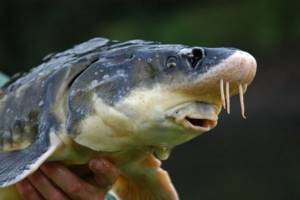
The sturgeon's mouth allows it to deceive an inexperienced fisherman
Donka
Feeder gear should be used closer to autumn, when the sturgeon begins to go deeper or in reservoirs with a pronounced element of aeration. In a place where fresh water enters the pond, there is much more oxygen, which means that fish, including sturgeon, are found here more often. However, the difficulty is that it is most often impossible to throw a float tackle into such a place, and there is always a current there, sometimes very strong. This is where the donka comes to the rescue.
The equipment is also simple. Conventional installation with a feeder and one or two leashes. The rod is selected based on the fishing location and the required casting distance. The fishing line is a 0.2-0.3 mm braid, capable of transmitting the lightest touches of the sturgeon to the bait. The reel is inertialess. A feeder that allows you to hold the tackle in the current. Leashes 0.5-1 m long. Hooks No. 5-8.
If two leashes are used at once, then one is placed below and the second above the feeder.
Bait for sturgeon
Since the sturgeon is a predator, it prefers bait of animal origin. Nevertheless, even plant baits give good results.
Animal bait
Having the following bait of animal origin with you, you are unlikely to return from fishing without a trophy:
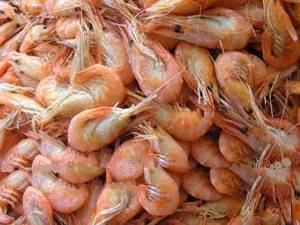
- Malek. Large fry should be used. The fry can be planted both lengthwise and crosswise. The main condition is that after installation it completely hides the hook tip.
- Herring. Using this bait gives very good results. It is important that before fishing, the herring is marinated in a mixture of unrefined oil, onion and garlic. If you don’t want to deal with bait yourself, you can buy ready-made pickled herring in the store. Before planting, it is cut into small cubes. Fillet from the back is best suited, as the meat there has the necessary density. It is necessary to attach the herring so that the hook tip is completely hidden.
- Smoked capelin. Another bait that this predator really likes. The capelin needs to be planted whole; for reliability, you can additionally tie it to the hook with thread. For bait, you need to choose medium-sized capelin so that the sturgeon can swallow it completely.
- Crawling worm. Worms need to be planted across several pieces. As a result, a ball of wriggling worms should form on the hook. To prevent small fish from taking the bait, the worms can be wrapped in mesh.
- Shrimp. Very often, really large specimens are caught on shrimp. Shrimp can be used both raw and boiled. If you want to catch a trophy fish, then you should attach the whole shrimp. If the fish stops actively biting, then you can try fishing with peeled shrimp. This often activates bites.
- Squid. Squid meat is an excellent bait. Frozen squid, which are sold in every supermarket, is suitable. Before fishing, the carcass must be thawed and cut into small pieces. You can put several pieces on the hook to hide the sting. The squid holds perfectly on the hook, it will not be washed away by the current, and even with an active bite, the bait does not get dislodged.
- Liver. You can also fish with beef liver. To do this, the day before fishing, you need to cut it into long, thin strips, weigh it down with something heavy and leave it overnight. This will make the liver dense, and it will “sit” perfectly on the hook.
Vegetable baits
- Millet porridge. Although the sturgeon is a predator, it also loves to eat millet porridge. Preparing millet is quite simple: the porridge is boiled until the millet swells greatly, and then covered with a lid and steamed until it has a consistency so that it can be cut into cubes. After this, the porridge can be placed on the hook.
- Dough. To prepare this bait, you can use both wheat and corn flour. It is mixed with a small amount of unrefined sunflower oil until smooth. Then small balls are rolled out from the dough and placed on the forend, several at a time.
- Corn. This king fish also bites on corn. And both canned and boiled. Be sure to plant several grains to make the bait seem more voluminous.
- Peas. Not the most popular bait, but it can help out at the right time. The easiest way to cook peas is in a thermos. To do this, you need to pour one part of whole peas into a thermos and pour five parts of boiling water over it. Add soda there, at the rate of: 1 tbsp per 1 liter. water. Then close the thermos tightly and leave the peas for 6 hours. After this, it can be used as bait.
Bait
Shrimp may be suitable as bait.
The sturgeon prefers bait that moves, in other words, of animal origin. If you decide to use herbal options and combinations, then you should use additives with rather sharp and strong odors.
Since the fish feed from the bottom, the bait should be within its reach - on the bottom. The consistency of the bait should not be hard, as it may confuse it with a stone and spit it out.
Also, due to its physiological characteristics (large mouth), the bait should be used in medium or large sizes. The ideal bait is considered to be whitebait, especially freshly caught ones.
Bait requirements
When searching for food, the sturgeon primarily relies on its sense of smell. Therefore, if you want to attract him to your bait, it must be fragrant. It is advisable to marinate meat baits using onions, garlic and dill. Vegetable baits need to be flavored with a variety of flavorings, for example, anise drops, garlic or unrefined sunflower oil.
Sturgeon is a bottom-dwelling fish, so for fishing to be successful, the bait must lie on the bottom. It is also necessary to monitor how the bait is positioned on the hook. It should not dangle or fly off the forend at the slightest touch.
The bait should not be blown away by the current. If you decide to fish for fry, it must be the type of fish that is found in the reservoir where you are supposed to be fishing. Sturgeon is a cautious fish, so food that is unfamiliar to it is more likely to scare it away than to attract it.
The best baits and lures
Baits for sturgeon can be either animal or vegetable, but animal baits are still considered preferable and more promising. Of the animal baits familiar to most fishermen, it is worth noting worms, where dung and crawling baits occupy leading positions. Sturgeons are successfully caught using as bait the fry of the fish species that lives in the fished reservoir. Well-known attachments include beef liver.
More specific, direct sturgeon baits include pieces of pickled or salted herring, small-sized smoked capelin, shrimp and squid, which are purchased in grocery stores that specialize in fish. Of the plant-based baits, the most practical is to use canned sweet corn, steamed or boiled peas, as well as all kinds of flavored doughs. Good results are shown by fishing with millet porridge prepared in a unique way, which is placed on hooks and cut into small cubes.
Weaning process
For successful fishing, you need to use bait mixtures. The consistency of the bait should be such that, once in a reservoir, the ball molded from the bait does not fall apart, but reaches the bottom whole or at least in large pieces.
What ingredients to use
When preparing bait mixture, you can use the following components:
- Boiled millet.
- Ground crackers.
- Cake.
- Ground roasted sunflower seeds.
- Roasted ground hemp seeds.
- Hercules.
- Chopped worms.
- Bloodworm.
- Chopped herring fillets, etc.
Before adding bloodworms to the bait, it is necessary to soak them in water, otherwise after casting the bait they will begin to float. Also, you don’t need to make the bait mixture too nutritious, or if the mixture is nutritious, then you don’t need to throw it too often so as not to overfeed the fish.
How to feed
Some tips on how to feed sturgeon:
- During fishing, the bait should form a fragrant spot on the bottom of the reservoir. It is important that it does not create turbidity, as this will attract a lot of small fish. Therefore, it is necessary to throw a large amount of bait, but do this with long breaks in time.
- Feeding needs to be done pointwise. It is advisable that you deliver the bait to a point with a radius of no more than 1 meter.
- In order to cast as accurately as possible, it is necessary to mold the bait into balls of the same size.
- To deliver the mixture to a point far from the shore, you will have to use a slingshot.
Fishing technique
Sturgeon fishing with a float rod is similar to carp fishing. Only the predator bites differently. When he tries the bait, the float shakes slightly, at this moment you need to be ready to hook. When the fish bites, the float sharply goes under the water, at this moment it is necessary to hook the prey. To do this, you can feed the line perpendicularly down.
The situation is the same with donk fishing. First, the tip of the rod will begin to tremble a little, after which it will sharply bend into an arc - at this moment you need to make a hook.
Often the sturgeon breaks the leashes in the initial stage of fishing. Therefore, you need to “pluck” it from the bottom very carefully. But even if at the initial stage everything went as it should, it’s too early to relax. This fish will try to cause you problems by any means. It can tangle the tackle, rush as fast as it can in your direction or, conversely, away from you, try to lie to the bottom.
Fishing for a sturgeon should be done slowly, patiently bringing it to the shore. A well-tuned friction brake will make fishing easier. Be prepared for the fact that just before the shore the sturgeon may make a last attempt to escape. He will make a so-called candle - he will jump high above the water. At this moment you need to try to throw it ashore.
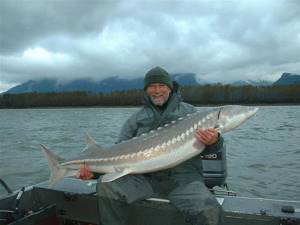
Features of sturgeon fishing
Depending on the location, sturgeon fishing has some peculiarities. Let's look at them.
From shore and from boat
- When fishing from the shore, on average, you should change locations every 30 minutes.
- For the convenience of fishing from a boat, you can use a short spinning rod as a donkey.
- If you decide to go to a wide body of water, then fishing from a boat will be more effective than from the shore.
- When throwing bait from the shore, take into account the strength of the current in the reservoir. It is important to calculate as accurately as possible where to throw the tackle after the bait has been carried away by the current.
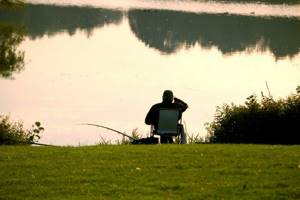
On paid reservoirs
- The main feature of this kind of fishing is that you know in advance that there are fish in the reservoir. Accordingly, all that remains is to catch her.
- On paid ponds it is important to choose the right bait, otherwise you will be “overcome” by small fish.
- If the day before fishing you notice that the weather is starting to change for the worse, then it’s better not to go to the paid site - you’ll be wasting your money. The sturgeon reacts very sensitively to pressure changes and temperature changes and stops pecking.
What season is best to fish?
The fishing season is divided into 4 periods, each of which has its own biting characteristics:
- Winter period. The sturgeon almost does not react to the treat offered to it; catching it is difficult and almost unsuccessful. Using live bait will help improve a weak bite.
- Spring period. At the end of March, after the first warm weather, the sturgeon bite increases significantly, and you can start fishing from the shore or from a boat.
- During the summer period , the most active sturgeon bite is observed; they easily capture the correctly chosen bait.
- Autumn period. The bite is no longer the same as in summer; the fish sink to the bottom of reservoirs and are difficult to lure to the surface. However, using bottom tackle and bait that is tasty for sturgeon, you can achieve a good bite.
Blitztips
- When pulling fish out of the water, you will need a large carp landing net. If it is not there, then you can pull out the sturgeon with your hands. It is important to wear thick gloves, otherwise the fish may injure you.
- Do not use hard baits - the sturgeon will mistake them for stones and spit them out.
- The legislation of the Russian Federation prohibits the use of more than 5 hooks when fishing with a donk.
- Do not use small baits - the fish simply will not notice them.
- If you fish for sport, you can safely release the caught sturgeon back into the water - the hooks practically do not injure them.
What do sturgeon bite on in winter?
It is difficult to predict what sturgeon will bite on in winter on the day of fishing. You need to stock up on different baits, and when fishing on platoons, also with plant baits. In natural conditions, focusing on its usual diet, it is better to use bait for sturgeon.
Baits for sturgeon in winter
List of catchable baits for sturgeon:
- Icelandic canned herring in wine sauce. For hanging on a hook, it is cut into pieces 1.0-1.5 cm in size. It is better to cut the bait in advance;
- Fresh liver . Also cut into small pieces. Disadvantage: in cold water it quickly loses its properties. If there is no bite for half an hour or longer, the bait should be renewed;
- Smoked capelin. Large fish are cut into pieces, and small fish are planted whole;
- Bloodworm. Placed in a bunch. It is more convenient to prepare bunches of bloodworms in advance, and when fishing, attach them to the hook using an elastic band;
- Worms. Traditional fishing bait, also suitable for catching winter sturgeon. A large bunch is placed on the hook;
- Shrimps. This is the usual prey of sturgeon in natural conditions.
Baits for sturgeon in winter
When catching sturgeon in winter in natural habitats, vegetable baits are used as an addition to bait. So-called “sandwiches” are placed on the hook.
To catch sturgeon from ice in specially stocked reservoirs, you can use vegetable baits separately.
Plant baits for sturgeon in winter:
- Prepared dough for fishing from wheat or corn flour;
- Canned or cooked corn;
- Millet;
- Peas.
